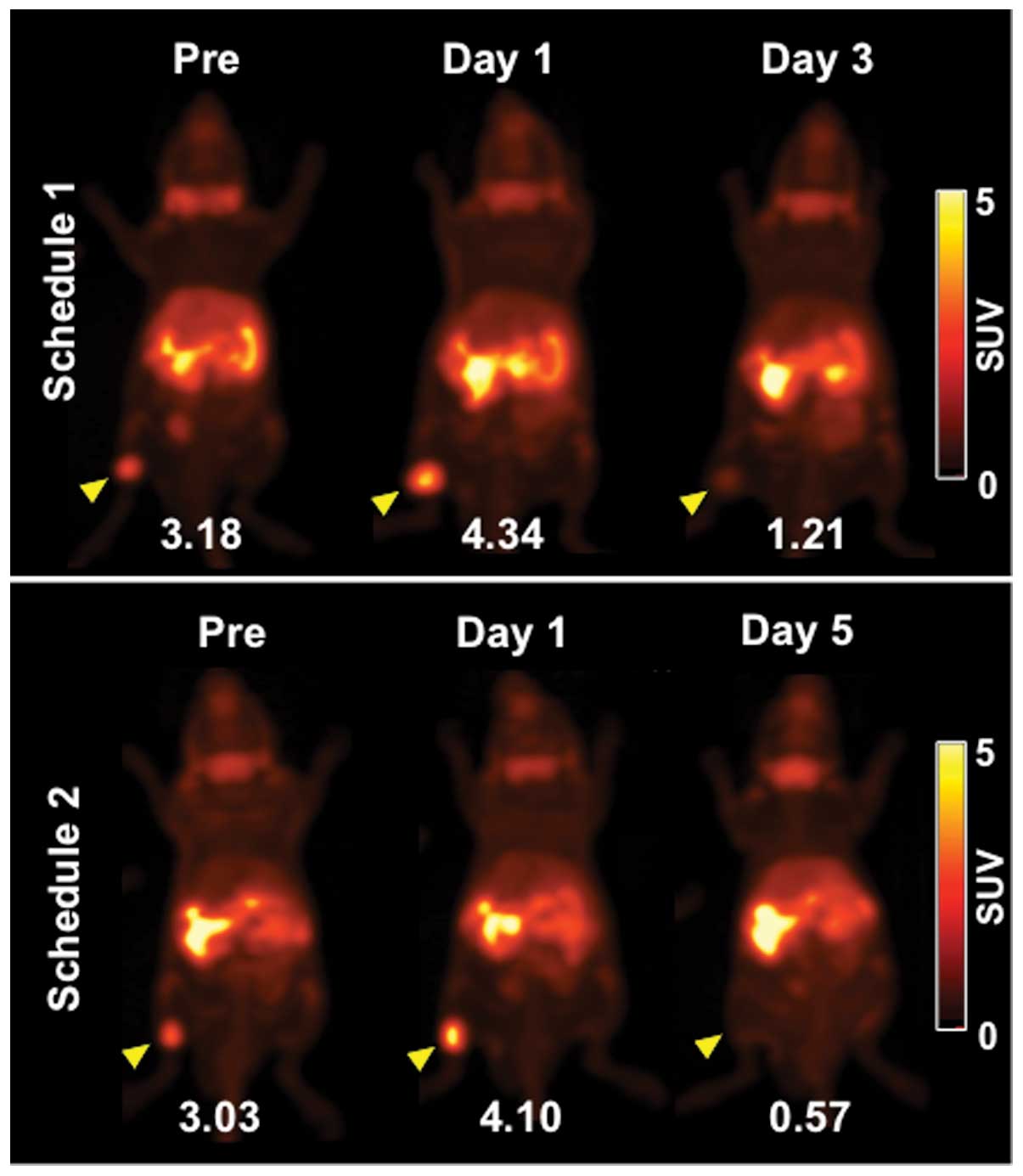Preclinical assessment of early tumor response after irradiation by positron emission tomography with 2-amino-[3-11C]isobutyric acid
- Authors:
- Atsushi B. Tsuji
- Aya Sugyo
- Hitomi Sudo
- Chie Suzuki
- Hidekatsu Wakizaka
- Ming-Rong Zhang
- Koichi Kato
- Tsuneo Saga
-
View Affiliations
Affiliations: Diagnostic Imaging Program, Molecular Imaging Center, National Institute of Radiological Sciences, Inage-ku, Chiba 263-8555, Japan, Biophysics Program, Molecular Imaging Center, National Institute of Radiological Sciences, Inage-ku, Chiba 263-8555, Japan, Molecular Probe Program, Molecular Imaging Center, National Institute of Radiological Sciences, Inage-ku, Chiba 263-8555, Japan
- Published online on: March 20, 2015 https://doi.org/10.3892/or.2015.3868
-
Pages:
2361-2367
Metrics:
Total
Views: 0 (Spandidos Publications: | PMC Statistics:
)
Metrics:
Total PDF Downloads: 0 (Spandidos Publications: | PMC Statistics:
)
This article is mentioned in:
Abstract
The positron emission tomography (PET) probe, 2-amino-[3-11C]isobutyric acid ([3-11C]AIB), is reported to accumulate less in inflammatory lesions than 2-deoxy-2-[18F]fluoro-D-glucose ([18F]FDG) and has the potential for evaluation of the efficacy of radiotherapy. To determine whether [3-11C]AIB is useful to monitor early metabolic change in tumors after radiotherapy, we evaluated the temporal change in [3-11C]AIB tumor uptake, tumor volume, histological features and expression of amino acid transporters early after radiotherapy in a mouse tumor model. PET with [3-11C]AIB was conducted in mice bearing a subcutaneous tumor (SY, derived from small cell lung cancer) in two schedules: schedule 1, before (day -1) and after (days 1 and 3) 15 Gy of radiation and schedule 2, days -1, 1 and 5. [3-11C]AIB tumor uptake tended to increase on day 1 after irradiation and decreased thereafter. Tumor uptake was not correlated with tumor volume in schedule 1. Although tumor uptake was correlated with tumor volume in schedule 2, this correlation was lost when the day 5 data of greatly reduced tumor volumes were excluded. In a separate group of tumor-bearing mice, excised tumor sections were stained with terminal deoxynucleotidyl transferase-mediated deoxyuridine triphosphate nick-end labeling (TUNEL) or anti-Ki-67 antibody. There was no correlation between tumor uptake and percentages of TUNEL- or Ki-67-positive cells. Expression of amino acid transporters, SLC38A1, SLC38A2 and SLC38A4, was determined by real-time RT-PCR. SLC38A1 and SLC38A2 were expressed in SY tumors, and a significant correlation was observed between [3-11C]AIB tumor uptake and SLC38A1 expression. In conclusion, early change in [3-11C]AIB tumor uptake after irradiation reflected the temporal change in amino acid transporter expression, while it was independent of change in tumor volume, apoptosis and cell proliferation. PET with [3-11C]AIB has the potential for use in non-invasive evaluation of early metabolic change after irradiation before morphological change of tumors.
View References
|
1
|
Halperin EC, Perez CA and Brady LW: Perez
and Brady’s Principles and Practice of Radiation oncology. 5th.
Lippincott Williams & Wilkins; Philadelphia, PA: 2008
|
|
2
|
Van de Wiele C, Lahorte C, Oyen W, Boerman
O, Goethals I, Slegers G and Dierckx RA: Nuclear medicine imaging
to predict response to radiotherapy: a review. Int J Radiat oncol
Biol Phys. 55:5–15. 2003. View Article : Google Scholar
|
|
3
|
Juweid ME and Cheson BD: Positron-emission
tomography and assessment of cancer therapy. N Engl J Med.
354:496–507. 2006. View Article : Google Scholar : PubMed/NCBI
|
|
4
|
Bading JR and Shields AF: Imaging of cell
proliferation: status and prospects. J Nucl Med. 49:64S–80S. 2008.
View Article : Google Scholar : PubMed/NCBI
|
|
5
|
Shreve PD, Anzai Y and Wahl RL: Pitfalls
in oncologic diagnosis with FDG PET imaging: physiologic and benign
variants. Radiographics. 19:61–77. 1999. View Article : Google Scholar : PubMed/NCBI
|
|
6
|
Love C, Tomas MB, Tronco GG and Palestro
CJ: FDG PET of infection and inflammation. Radiographics.
25:1357–1368. 2005. View Article : Google Scholar : PubMed/NCBI
|
|
7
|
Haberkorn U, Strauss LG, Dimitrakopoulou
A, et al: PET studies of fluorodeoxyglucose metabolism in patients
with recurrent colorectal tumors receiving radiotherapy. J Nucl
Med. 32:1485–1490. 1991.PubMed/NCBI
|
|
8
|
McConathy J and Goodman MM: Non-natural
amino acids for tumor imaging using positron emission tomography
and single photon emission computed tomography. Cancer Metastasis
Rev. 27:555–573. 2008. View Article : Google Scholar : PubMed/NCBI
|
|
9
|
Tsuji AB, Kato K, Sugyo A, et al:
Comparison of 2-amino-[3-¹¹C]isobutyric acid and
2-deoxy-2-[18F]fluoro-D-glucose in nude mice with
xenografted tumors and acute inflammation. Nucl Med Commun.
33:1058–1064. 2012. View Article : Google Scholar : PubMed/NCBI
|
|
10
|
Kato K, Tsuji AB, Saga T and Zhang M-R: An
efficient and expedient method for the synthesis of
11C-labeled α-aminoisobutyric acid: a tumor imaging
agent potentially useful for cancer diagnosis. Bioorg Med Chem
Lett. 21:2437–2440. 2011. View Article : Google Scholar : PubMed/NCBI
|
|
11
|
Yoshida C, Tsuji AB, Sudo H, et al:
Therapeutic efficacy of c-kit-targeted radioimmunotherapy using
90Y-labeled anti-c-kit antibodies in a mouse model of small cell
lung cancer. PLoS one. 8:e592482013. View Article : Google Scholar : PubMed/NCBI
|
|
12
|
Hautzel H and Müller-Gärtner HW: Early
changes in fluorine-18-FDG uptake during radiotherapy. J Nucl Med.
38:1384–1386. 1997.PubMed/NCBI
|
|
13
|
Maruyama I, Sadato N, Waki A, et al:
Hyperacute changes in glucose metabolism of brain tumors after
stereotactic radiosurgery: a PET study. J Nucl Med. 40:1085–1090.
1999.PubMed/NCBI
|
|
14
|
Rozental JM, Levine RL, Mehta MP, et al:
Early changes in tumor metabolism after treatment: the effects of
stereotactic radiotherapy. Int J Radiat Oncol Biol Phys.
20:1053–1060. 1991. View Article : Google Scholar : PubMed/NCBI
|
|
15
|
Mackenzie B and Erickson JD:
Sodium-coupled neutral amino acid (System N/A) transporters of the
SLC38 gene family. Pflugers Arch. 447:784–795. 2004. View Article : Google Scholar
|
|
16
|
Nakanishi T and Tamai I: Solute carrier
transporters as targets for drug delivery and pharmacological
intervention for chemotherapy. J Pharm Sci. 100:3731–3750. 2011.
View Article : Google Scholar : PubMed/NCBI
|
|
17
|
Furuta M, Hasegawa M, Hayakawa K, et al:
Rapid rise in FDG uptake in an irradiated human tumour xenograft.
Eur J Nucl Med. 24:435–438. 1997.PubMed/NCBI
|















